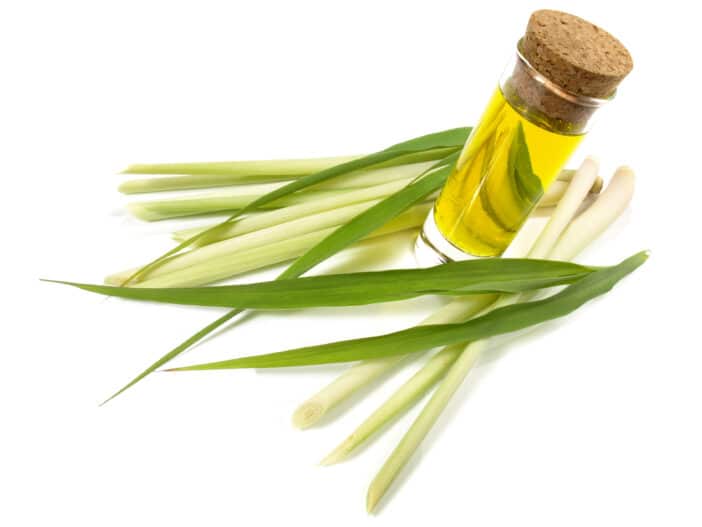Lemongrass

The use of lemongrass in the kitchen
Lemongrass has a slightly lemony flavour and a subtle rose fragrance.
In Asian countries, the fresh leaves are used to make a thirst-quenching tea. They are also suitable for refining Asian and Mediterranean dishes. The plant has another interesting effect, however, because its essential oil repels insects and vermin in the kitchen.
Lemongrass in naturopathy and aromatherapy
In naturopathy and aromatherapy, it is mainly the essential oil that is used, which is found mainly in the stems with a content of up to 0.5 percent.
Lemongrass has a stimulating effect on our state of mind and drives away gloomy thoughts. It makes us optimistic, helps against lethargy and nervousness, promotes concentration and counteracts mental exhaustion. If the temples and forehead are rubbed with the essential oil, headaches are often reduced. Inhaling lemongrass oil provides relief from colds and sinusitis. It has an antispasmodic effect on gastrointestinal complaints and vomiting diarrhea. Sprains and rheumatic complaints can be alleviated with rubs. In a fragrance lamp, lemongrass neutralises bad odours such as stale cigarette smoke. It is also said to prevent varicose veins because it strengthens and dilates the blood vessels. Lemongrass has a firming effect on weak connective tissue.
The ingredients of lemongrass
Lemongrass is rich in valuable ingredients. Among other things, it contains 1,8-cineole, citronellal, citronellol, alpha-pinene, alpha-camphorone, alpha-terpineol and beta-sitosterol. It also contains magnesium, manganese, L-linalool, geraniol, rutin, quercetin and limonene.
Lemongrass for cosmetic formulations
Due to the aforementioned firming effect on the connective tissue, lemongrass is an excellent ingredient for massage oils and body lotions. Those who suffer from cellulite should regularly rub their thighs with a lemongrass cream. Furthermore, lemongrass contributes to a healthy and beautiful complexion. The antioxidants it contains fight free radicals and can reduce signs of ageing such as pigmentation spots or small wrinkles. The invigorating, toning and circulation-enhancing effect leaves the complexion looking fresh, radiant and rosy. Thanks to the antiseptic effect, inflamed areas usually calm down very quickly and minor injuries and skin cracks heal faster. This can also prevent the formation of skin blemishes. Due to its germ-, fungus- and bacteria-killing as well as deodorising properties, the plant is also very suitable for soaps, washing lotions, bath additives and shower gels. The flowery, lemony scent is perceived by most people as very pleasant, fresh and stimulating, as it has a positive effect on the overall well-being.
Fact Sheet Lemongrass (Oil)
INCI: Cymbopogon Flexuosus Herb Oil
CAS number: 91844-92-7
EINCS / ELINCS: 295-161-9
Extraction: by steam distillation from Cymbopogon flexuosus
Plant family: Poaceae (sweet grasses)
Description: a pale yellow to orange oil with a lemony fragrance
Solubility: soluble in ethanol
Main constituents: 1,8-cineole, citronellol, citronellal, limonene, linalool
Effect: antiseptic, antibacterial, stimulating and invigorating, antioxidant, vasodilator, stimulates lymph flow, firming
Modern and innovative cosmetics with lemongrass
With its fresh and invigorating scent, lemongrass is a true blessing for body, mind and soul. In addition, the essential oil has many positive effects on our skin. It tightens the connective tissue, prevents skin impurities, has an antioxidant effect and improves the skin’s appearance. Find out more about the many uses of lemongrass at Cosmacon.
Literature
Kiełtyka-Dadasiewicz A, Ludwiczuk A, Tarasevičienė Ž, Michalak M, Głowacka A, Baj T, Kręcisz B, Krochmal-Marczak B.J Oleo Sci. 2021;70(1):125-133
Lemongrass Essential Oil Components with Antimicrobial and Anticancer Activities.
Mukarram M, Choudhary S, Khan MA, Poltronieri P, Khan MMA, Ali J, Kurjak D, Shahid M.Antioxidants (Basel). 2021 Dec 22;11(1):20.
Oliveira MAC, Borges AC, Brighenti FL, Salvador MJ, Gontijo AVL, Koga-Ito CY.Braz Oral Res. 2017 Nov 6;31:e89